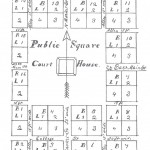Marion was located and name August 20, 1839 by three commissioners from nearby counties appointed by the legislature. Calvin Bridges of Union, Thornberry C. Anderson of Gallatin and Jefferson Allen of Jackson County met at Bainbridge August 19th and were sworn by Justice of the Peace William Norris to locate the new county seat as they could find a suitable site. Each commissioner was paid $12 for his services.
William and Bethany Benson made the county a deed of gift that same day to twenty acres selected for the new town site. Their deed was the first County Clerk John Bainbridge entered on his new book.
When the commissioners decided on the site in Poor Prairie, the Bensons had few neighbors. The Aikman family to the west, the Elijah Spiller family to the north, the Goodall family to the southeast, Silas Gratton and James McCoy lived near enough to be called neighbors.
No record was made of the reason for naming the town, but Francis Marion the “swamp fox” was one of the Revolutionary war heroes whose exploits were still common talk. At least one of Francis Marion’s soldiers still lived in the county named Josh Tyner (Bleyersville). The other sons and nephews of Francis Marion’s men who had made the county their home felt the name eminently suitable for their new county seat.
The original town of Marion included the Public Square and one row of blocks around it, forty seven in all. County Surveyor Perry was paid $12 for his work and $2 each was paid his assistants: James Henderson, Dempsey Odum, Archibald T. Benson and Elijah N. Spiller.
Sheriff John D. Sanders supervised the public sale of lots beginning November 1, 1839 and running three days. Thirty eight lots were sold for a total of $2,409.50 on credit. William I. and Archibald T. Benson bought the most valued corners of the square, the North side of West Main Street for $161.25, the West side of North Market Street for $150. These funds were the first source of revenue for the county save for the licenses issued by the county commissioners, and were used to construct the first Marion court house.
A town charter was secured by special act of the legislature February 24, 1841. An area one square mile, with the public square as the center, was specified as the town of Marion. In 1856 a regular village charter was secured and the village recieved its first impetus to industrial growth when the first rail of the Carbondale and Shawneetown Railroad was laid into Marion on January 15th 1872. Although the railroad never extended east of Marion it became part of the Illinois Central system and furnished Marion its first outlet.
In 1874 Marion was granted is charter as a city, the first in the county. The mayor of 1874 was Joseph W. Hartwell, the first aldermen were M.W. Robertson, Hartwell Hendrickson, Robert M. Allen (son of Willis Allen), John M. Young, Charles M. Edwards the miller, and Augustus N. Lodge, the county superintendent of schools.
(Extracted and edited from Pioneer Folks and Places, Barbara Barr Hubbs; map from 1905 Souvenir Book, WCHS; compiled by Sam Lattuca 12/13/2012)

